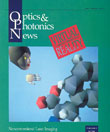Feature Articles
Virtual Reality: Is Seeing Believing?
The road to VR has been dotted with pixel improvement and evermore intricate computer graphics. As the fledgling technology advances, the task of defining "virtual reality" may prove arduous. Few who create virtual worlds agree on just what "virtual reality" means.
by Susan M. ReissOptical Phase Conjugation In The Ussr
A phenomenon of phase conjugation (PC) in nonlinear optical processes was discovered in the USSR in 1971 at about the same time in two laboratories—the Institute of Physics of the Belorussian Academy of Science and the Physical Institute of the USSR Academy of Science—for two different conditions, e.g., four-wave interaction and stimulated scattering of light. These two phenomena differ radically in their physical nature. In the first case, a nonlinear medium is permeated with two counterpropagating pump waves (reference waves). The so-called signal wave subjected to phase conjugation is also directed at this medium. To induce wave interaction in media with cubic nonlinearity, the frequencies of the reference and signal waves are chosen to be near, which gives rise to a fourth wave that propagates in the direction opposite that of the signal wave propagation. This wave, called a phase-conjugated wave, builds on the energies of the reference waves. Reflectivity equal to the power ratio of the phase-conjugated and signal waves can reach values largely exceeding unity. This is a threshold-free method of phase conjugation, as reflectivity has a weak dependence on the signal wave amplitude.
by G. A. PasmanikScratch and Dig Proposal Would Enhance Standardization
Here's news for all who thought they'd never see a change in the U.S. MIL-O-13830A Scratch and Dig standard: The Army is recommending a change in drawing number 7641866 that defines the standard scratch artifact. The change will lead to an objective measure of scratch visibility rather than the subjective one used by trained inspectors for the past 40 years. It will also bring the principle of the U.S. scratch test more in line with recent international thinking about optical surface inspection methods.
Pinholes and Lenses
Many people know that lenses can produce sharp images on a screen. But there are some interesting properties of lenses that are quite surprising, both to youngsters and adults. Furthermore, a pinhole is in some ways very similar to a lens, in other ways quite different.
by Fred GoldbergNonconventional Laser Imaging Using Sampled-Aperture Receivers
One of the maxims of high resolution imaging, especially for military surveillance applications, appears to be that the sensors you have on hand never quite deliver the image detail you really need. The reasons for this are manifold, but the factors fundamentally limiting image resolution in optical sensors can usually be attributed to limits in sensor fabrication technology, vagaries of the sensor operating environment, and insufficient signal energy with which to form the image.
by Paul S. Idell and David G. Voelz

![Infinity Mirrored Room– Brilliance of the Souls 2014 by artist Yayoi Kusama. [© YAYOI KUSAMA]](https://opnmedia.blob.core.windows.net/$web/opn/media/images/articles/2024/0724/departments/202407-cover-web.jpg?ext=.jpg)
![An experimental scheme demonstrated by researchers at Princeton and Yale universities, USA, can convert physical noise into errors that can be corrected more easily. [F. Wojciechowski, Princeton University]](https://opnmedia.blob.core.windows.net/$web/opn/media/images/articles/2024/0624/departments/202406-cover-web.jpg?ext=.jpg)
